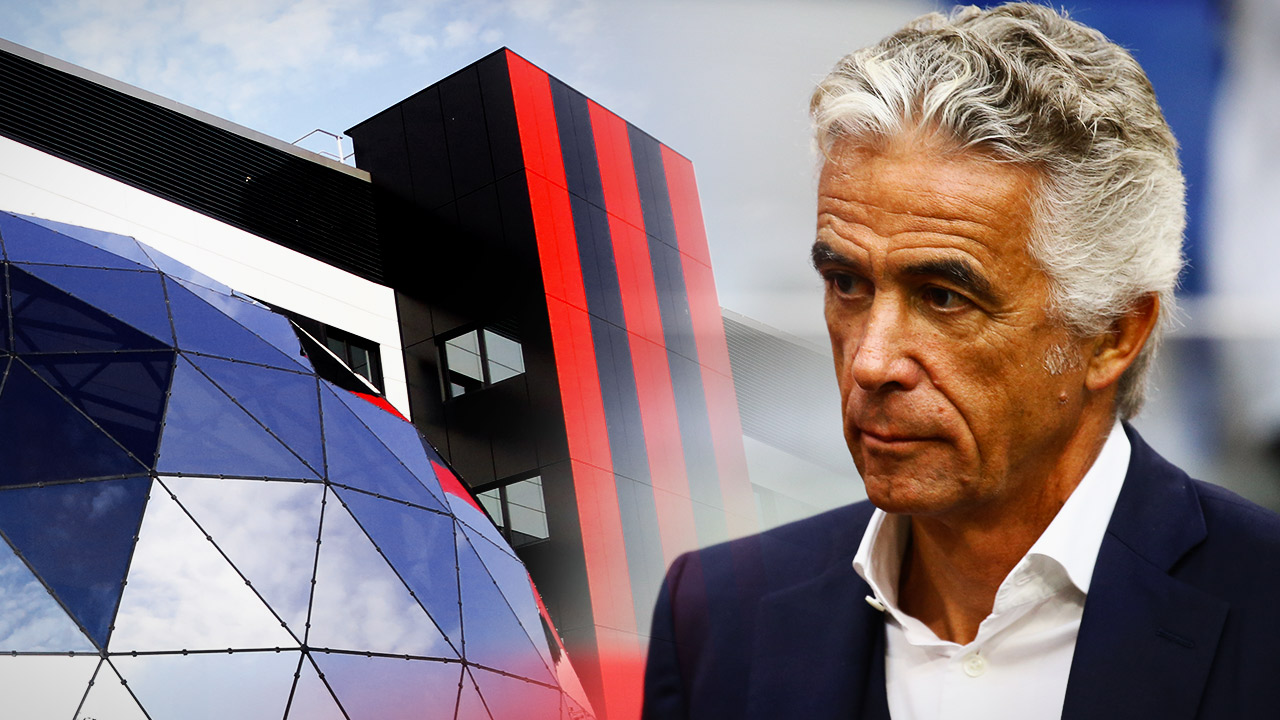
Training Center
J-P. Rivère: “The camp, it's the heart of the reactor”
When you arrived in 2011, the team played at the Ray, trained on the pitches of the Parc des sports Charles-Ehrmann, and the club had a small shop on Rue Lépante. What did the entrepreneur inside of you think of these structures?
That we had work ahead of us. I wouldn't have got involved without knowing that we had a new stadium on the horizon. When I arrived at the shop at Lépante, I was a bit embarrassed that our image was represented like that. We couldn't stay there. It was everything but commercial. It was the easiest thing to deal with. We needed to get by so that we could end the commitments that we had and then to find the best location. That had a cost, the rent was higher than what we had before. But when you invest, you have to look at the long-term. I was hoping to get us located on the Place Masséna, because it's an iconic spot in Nice, known by all Niçois and there are a lot of tourists who pass through. There, where we lost money in the previous activity, we are earning it today. Our turnover is on a different level. But to begin with, if you don't invest, you can't get a return out of it.
Your infrastructures are your tools for working. It's the same thing for the stadium. It isn't a source of immediate revenue but it will be eventually. It is essential.
And what were your thoughts about Charles-Ehrmann?
It's worse. It's the heart of the reactor and yet, everything is obsolete. When you want to build stories, projects, you first need to build the foundations. From OGC Nice's point of view, it was already a question of fixing the rigour of the management, especially financially, to put in place ways of working. In reality, everything that is at the heart of a business. Julien Fournier (Managing Director) has worked incredibly on this area, like he has with the other areas.
The training ground is where the daily work takes place. The administrative departments, the pros, the youngsters... Before buying a player, we were obliged to tell them about our facilities. With Mario (Balotelli) like with others, we said: “careful, the changing rooms are 50 years old, the showers are 50 years old…” The centre at Charles-Ehrmann was a major handicap for the pros, just as it was for the youngsters. When you have a project built largely on the Academy, you can't accept to stay with these type of structures. We will now have a very attractive tool for the parents who entrust us with their children.
“It's the first time in my life that I have launched a large building project, a huge investment, without having the finances”
You very quickly spoke about the idea of building a new training ground...
After a year, I think, after having looked to understand the world of football and the activity. The first year, we lost a lot of money because of bad processes. So to start a project with empty pockets, that is complicated. Just as it is to find the right balance between sporting investment, and investment in club structures... The short term often leads you to only look at sporting investment. The challenge that we set ourselves, was to help the club to grow, to become structured. And that included the training ground. So that was very quickly one of our first priorities. We needed to find the location for it, there were discussions with the city. It could have been elsewhere, but I think it is good to be near to the stadium. And once it was done, and we could imagine the project, we needed to find the finances.
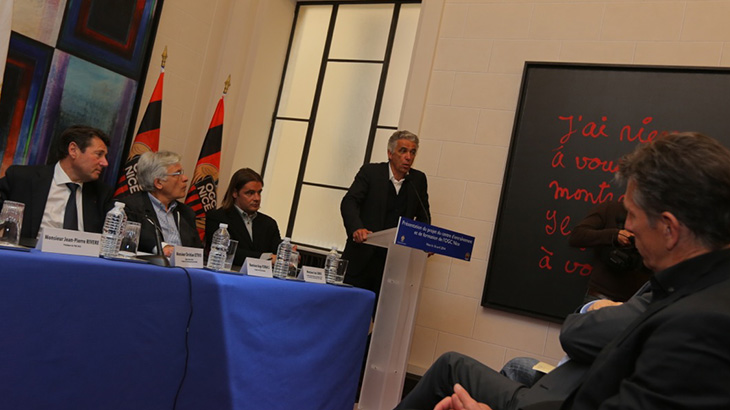
Not easy?
It's the first time in my life that I have launched a large building project, a huge investment, without having the finances. I decided to do it, because I had the stages in mind. There were also investors amongst them. But if we hadn't launched the project, we wouldn't have had the investors. At the beginning, we struck a deal where we said that the city would finance half, and the rest would be for us to finance. The city made a lot of effort, it acquired the property, they prepared the turf, and in 2019, they will build a complementary stand to go alongside the National 2 pitch.
So finally, we needed to be able to take on the building on our own. It's a very large investment. When you go to see the bankers and you put the words property and football together, nobody wants to see you. There's a dogma in France which says that football = lost money. It's anchored in their minds, and so everything linked to football scares them.
How did you manage it then?
By saying that we would find solutions. We have been waiting for this training ground for 30 years. At one time or another, you need to go for it. The BPI (public body) was a driving force. But it doesn't lend money unless there is another bank. As all the doors were closing, I went to see people that I knew from another life. I wanted to speak to the Caisse d'Epargne, and especially, to its President Christophe Pinault and CEO Jacques-Olivier Hurbal. We knew each other, we showed that we had heads on our shoulders, and so they accepted to finance us. I thank them for that. It allowed us to build the building, half with cash, and half as a loan.
Jordan Amavi's transfer also contributed...
That makes up a part of the finances for the build. It was the start of a circle. And it's a nice symbol for a player who came from the club's academy. We should have had him with us here this evening. But, since he had accepted, he has been called up for the French national side, something that we can only be happy about
“Our difficulty was building the training ground and at the same time, trying not to penalise the team on a sporting level”
The difficulties for the financing, do they explain why the training ground was announced for 2016 before finally only being inaugurated in 2017?
Yes, because we needed the means. Our difficulty was building the training ground and at the same time, trying not to penalise the team on a sporting level. Because the money that you put towards it, you are not putting it elsewhere. But if you don't do it at one stage or another, you go round in circles. Nothing happens.
What were the main objectives for this project?
The first was that all the components of the club needed to be brought together on the same site. One location should allow us to work even better.
It's essential because in the next five years, there won't be a huge influx of money coming in that will be able to raise our budget to the level of Lyon or Marseille. So to be able to go and challenge on the pitch, you need to move to a different approach – by working harder. And to do so, you need the right tools. The training ground is a performance tool. The evolution of OGC Nice's budget will be the fruit of our work.
The project was created with the input of several stakeholders. It got underway with Claude Puel, for example.
Claude was our coach at the time and we thought that we would be together for a long time. We asked him for his opinion on the sporting side of things, his expectations. He was involved and it's for that reason that we invited him to the inauguration. I hope that he will make it. Lucien (Favre) and his staff took over where he left off. So that the tool corresponds to all of their needs.
“We should keep a Portakabin without air conditioning for our next meetings with players' agents...”
Visually, the new training ground make a real impact. Does it give the idea that OGC Nice are now a rich club...
That is maybe the only handicap. Everyone will be thinking that we have money. That isn't the truth. We work and we invest to earn it. That's not the same thing. We joke about it with Julien (Fournier). We say to ourselves that we should keep a Portakabin without air conditioning for our next meetings with players' agents...
What will the new training centre change as far as the daily workings are concerned?
The conditions have nothing to do with it. It is very qualitative. Sporting facilities, the gym, ice baths, hot baths, rooms, the cafeteria... the youngsters will have the same level at their disposal as the pros do. When Dante visited the centre, he said to me: “If the youngsters don't succeed here, they will never succeed.”
It's ideal, everything has been optimised. Out on the pitches, but also for days when there is a double session. At the moment, a pro comes in the morning, trains, gets back into his car, then he comes back in the afternoon, etc. Now, they will be able to stay here, to rest, to work at the club all day. We are also going to able to do more nutritionally. Sporting success cannot be controlled, but the tools will be there to encourage it.
The current training ground is dilapidated, but the supporters had a real proximity with the players. How can you keep that?
Today, it's an open door. And that also presents its disadvantages, especially when the coach wants to organise a session behind closed doors when preparing for the next game. By making the training ground the nerve centre of all our operations, we couldn't stay open for all like that. But, we don't want to lose that proximity. So, we have made sure that there is an area reserved for supporters just next to the pitch, so that they can follow training, from up-close, just like today. You will see, that it will be the case when the team trains here for the first time, next Tuesday.
It also needs to be a place to share with our partners, with amateur football. We will organise lots of events so that people can take in this training centre. The different configuration mustn't cut out the conviviality.
“We will reap the rewards of the centre in the medium or long-term”
Will the new centre allow the club to bring in new revenue streams?
Not directly. Already, its construction which has cost 15.5 million Euros, is half financed by a loan that needs to be repaid each year. And then, there is the daily use. It's a building that measures 6500 m2. There is the upkeep, the catering, the renting of pitches to the city, all of that will represent a larger amount of work, quite different from what's required at the current training ground. Our main worry is to find a “namer” who comes to reduce that. We will also hold seminars, events, but it's not those things that will make up for it. It's down to us to find new revenue streams, in other areas. We will reap the rewards of the centre in the medium or long-term. Then it will be of real profit.
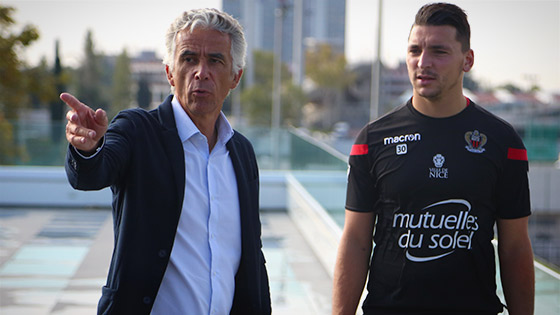
What major difficulties have you faced?
To get this project to the finish line, because it has required very heavy management and without a dedicated team. Companies have helped us, and given that internally, we didn't have anybody to manage a project like this, I found an easy solution by trusting my son, Florent, with the management of the site until the end of the furnishing. He had already worked on the file of the shop at Masséna. But, I didn't make things easy for him because the training ground was an enormous site, but I think that the results are here to see. And I am very happy with it.
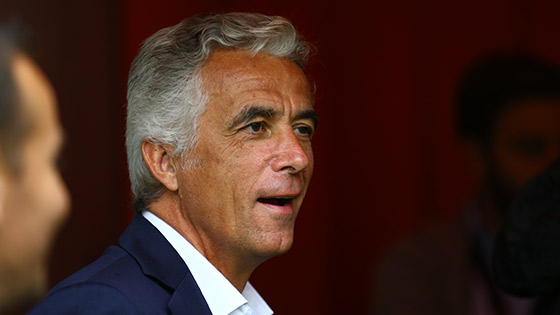
It's also your original profession. Have you added your own touch?
It's not exactly that, because this project is not at all like what we used to do. There is the sporting side, a school for the youngsters from the academy, offices... As for the touch that I could have added, yes, little things...
Like the little touch of adding a bowls pitch on the terrace...
(Smiles) I like playing bowls, but it must be only about four or five times a year that I get around to playing, no more. However, there are bowls pitches in a lot of our projects. It's very convivial. We created a residence where it became the living space. This kind of atmosphere needs to be found within the club, between the employees, the team, the staff... There needs to be life. It's also an ingredient of performance .But to be honest, our original idea was to open a restaurant (on the top floor, Editor's note), for the public. We know restaurants that work because they have a bowls pitch.
We are lucky to have a huge terrace. With this land, the parking, the restaurant, the clear brand of the club,... we were sure that we would fill it. It was a plus. But we had to put the project of a restaurant to one side, because in reality it was very difficult to manage in terms of the flow of people who work in the building and the visitors. We will therefore already understand the centre, to live it...
“When you enter inside...”
What are you favourite areas?
The terrace, we just spoke about it. There is also the pro dressing rooms. They are magnificent. But in first place, it's the Geode. When you enter inside....pffff. But there we go, I am not objective. A large amount of work was done by the communications team to decorate the building in our colours. With large images from our history, the names of all of our former players, the portraits of players we have trained. It's magnificent and it will be even more so in a couple of weeks when all of the walls will be dressed.
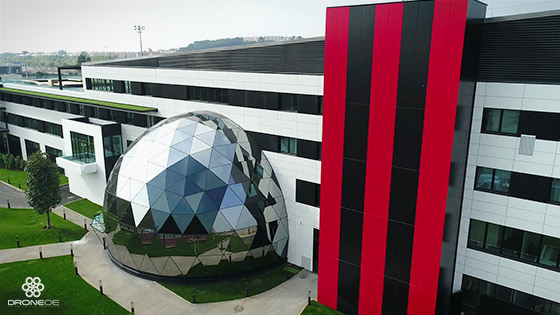
We have spoken about the aesthetics of the building and its functional characteristics, what can you say about the architect, Jean-Philippe Cabane…
Even though it has been many years that we haven't been able to work together, I have known Jean-Philippe for a very long time. He is brilliant. He has already put his name to some fantastic creations. And beyond all of his own qualities, he also has the huge skill of being there to listen. He has a very controlled ego. He is able to modify his projects, if necessary, based on what you say to him. It was once again a pleasure to work with him. He can be very proud of what he has created, with his teams and especially with his colleague Eric Grelin.
Is the club now ready to sail in terms of structures?
Yes. But every area needs to continue to improve, to set challenges, and to think that nothing is a fatality. Take for example the stadium. It is doing well today, but we need to be even more innovative in order to fill it, to have 50, 100, 200 points of sale for tickets in the city and throughout the region to go out and find fans. It's something we are going to put in place in the newspaper stands, thanks to a partnership we have set up with Nice-Matin. There are still many ideas to explore to continue to grow the club.
L.O.



